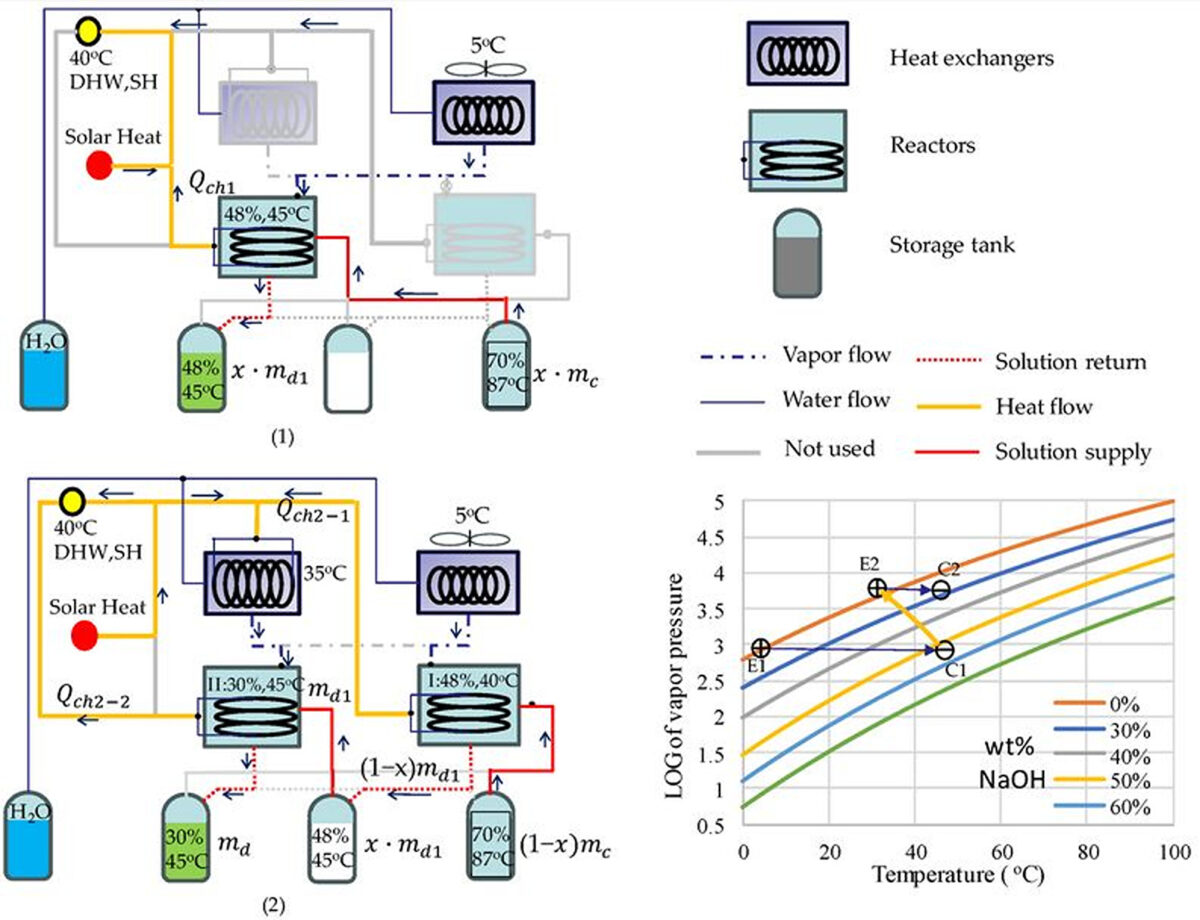Researchers from China's Zhejiang University designed a new solar-assisted thermochemical heat pump system that can be used for space heating, cooling and domestic hot water (DHW) in residential applications.
“In our work, we proposed a system that aims to achieve greater energy storage density,” the research's lead author, Guoqing He, told pv magazine. “Using a thermochemical heat pump allowed us to use more solar thermal energy and reduce electricity demand.”
The main feature of the system is that it relies on a working pair formed by sodium hydroxide (NaOH), which is also known as caustic soda, and water. According to the research group, the NaOH/water pair has advantages such as low price, high heat transfer coefficient, high energy density, short recovery time, and storage temperature compatibility with conventional solar-thermal collectors. “We demonstrate that this system can work with a concentration difference of 70% wt and 30% wt, respectively, for the climate in hot summer and cold winter regions in China,” He added.
The system consists of two NaOH reactors, two heat exchangers, four tanks, and solar-thermal collectors.”In the discharging process, the reactor acts as a heat pump, extracting heat from the low-temperature source through the evaporation of water,” the academics explained, noting that the NaOH reactors work each as a condenser or an evaporator. “The solution takes in water vapor and becomes diluted, releasing the extracted heat along with its stored chemical energy for heating. In the charging process, solar heat is used to regenerate the solution by desorbing vapor out of the solution. The solution becomes concentrated again and thus regains the potential to extract the heat from the low-temperature source for heating in the next cycle.”
The scientists simulated the performance of the heat pump system assuming it is utilized in a single-family house with a floor area of 220 m2 in Hangzhou, China. The expected annual total heating demand was 11,650 kWh, including winter space heating of 8072 kWh, winter DHW of 1298 kWh, and summer DHW of 2280 kWh.
Popular content
“During the non-heating seasons, the solar thermal collectors charge the solution and maintain it at a high temperature until the beginning of the heating season,” they said, describing the sytem operation. “Then, the solution acts as a heat pump, extracting heat from the low-temperature source and delivering it to the building, along with the solar heating from the collectors and the stored sensible heat in the solution. The solution becomes cooled and diluted at the end of the heating season, and is ready to be charged again.”
The analysis showed that the system can achieve an energy storage density of 363 kWh/m3. The group also found the heat pump needs 35.13 m2 of solar collectors and 32.47 m3 of storage tanks. “Compared with the sensible seasonal storage, the collector area is reduced by 12.5% and the storage space is reduced by 59%, with a possible further reduction through optimization,” they said, stressing the proposed system is a valid solution for residential buildings with limited space. “The collectors sized for discharging the solution during non-heating seasons can also produce a significant amount of solar heat for heating in winter.”
The research team also stressed that the initial investment for the system may still represent a challenge to overcome for its commercial maturity. “Our heat pump is very suitable for being integrated with PV in most climates,” He said. “Upfront costs, however, may still be too high.”
Looking forward, the researchers said they want to conduct a more detailed dynamic simulation. Their findings are available in the paper “Two-Stage Solar–NaOH Thermochemical Heat Pump Heating System for Building Heating: Operations Strategies and Theoretical Performance,” which was recently published in energies.
This content is protected by copyright and may not be reused. If you want to cooperate with us and would like to reuse some of our content, please contact: editors@pv-magazine.com.



By submitting this form you agree to pv magazine using your data for the purposes of publishing your comment.
Your personal data will only be disclosed or otherwise transmitted to third parties for the purposes of spam filtering or if this is necessary for technical maintenance of the website. Any other transfer to third parties will not take place unless this is justified on the basis of applicable data protection regulations or if pv magazine is legally obliged to do so.
You may revoke this consent at any time with effect for the future, in which case your personal data will be deleted immediately. Otherwise, your data will be deleted if pv magazine has processed your request or the purpose of data storage is fulfilled.
Further information on data privacy can be found in our Data Protection Policy.